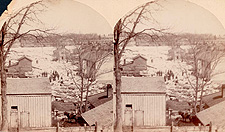Ice
There is a reason that Canada is nicknamed "The Great White North". In most parts of the country, we can count on the presence of snow and ice from late autumn through mid-spring. Normally, Canadians are prepared for anything winter can dish out, meeting snow and ice head-on. Bundled up in parkas and toques, Canadians enjoy the season by skiing, tobogganing, snowmobiling, playing hockey, building snowmen and smiling through billows of visible breath. But ice can be just as dangerous as it can be fun, and when it catches people off guard, the results can be disastrous.
To most Canadians, winter storms are probably the most familiar manifestations of the malevolent side of ice. They can come in the form of blizzards, snow squalls, snowbursts (sudden, severe snowfalls) and, in the Prairies, near-zero visibility blowing and drifting snowstorms called Alberta Clippers.
Most destructive, though, are ice storms. Freezing rain and thick sheets of ice can damage homes, snap limbs off trees and pull down power lines and hydro towers. During the Montréal ice storm of 1961, many residents were without hydro for days. Schools were closed, and thousands of people trekked from the suburbs to the downtown in search of heat, light and running water. On Christmas Day 1986, Ottawa was struck by an ice storm that left one in four homes without power and downed thousands of trees.
In winter storms, the snow comes one flake at a time. But in an avalanche, tonnes of snow come all at once in huge slabs or massive waves. An avalanche can move at up to 130 kilometres per hour, crushing and burying anything -- or anyone -- in its path. Over the years, hundreds of Canadians have died in avalanches, most of them railway workers, skiers or hikers in the Rocky Mountains.

Source
Ice flood, Belleville, 1885
During the 2002-03 winter season alone, 21 people died in avalanches in Canada. Among the most tragic of these events was the death of seven high-school students in British Columbia's Connaught Valley in February of 2003. They were not the first avalanche victims to garner widespread public attention, however. Just five years earlier, the nation was shocked when Michel Trudeau, youngest son of former Prime Minister Pierre Trudeau, was killed by an avalanche in BC's Kokanee Glacier Park. His body was never recovered.
Canada's oceans also hold icy dangers for ships and mariners -- in the form of icebergs. Up to 40,000 icebergs "calve", or break off, the Greenland ice cap every year and float south with the currents, threatening oil rigs, fishing boats and cargo ships. The largest icebergs can tower 90 metres in height (even though eight-ninths of their size is underwater) and weigh millions of tonnes. Even average-sized icebergs weigh in at between 100 and 200 thousand tonnes.
Although the most famous naval disaster involving an iceberg is the sinking of Titanic in 1912, with over 1,500 people dead there have been many other such disasters. In July 1981, for example, the 900-tonne Canadian survey ship Arctic Explorer struck an iceberg off Newfoundland and sank in a matter of 20 minutes. Thirteen crewmen died and 19 others drifted for two days in a life raft.
Theirs is an all-too-familiar story. Disasters involving ice have caused injuries, death and loss of property countless times over the course of Canada's history. In this section of the SOS! Canadian Disasters site, you will find information on some of the deadliest, most destructive and iciest disasters ever to strike the country -- incidents that will be forever frozen in Canadians' collective memory.